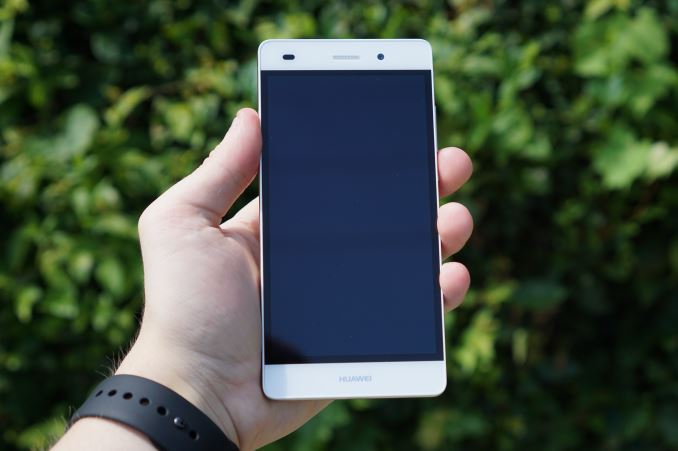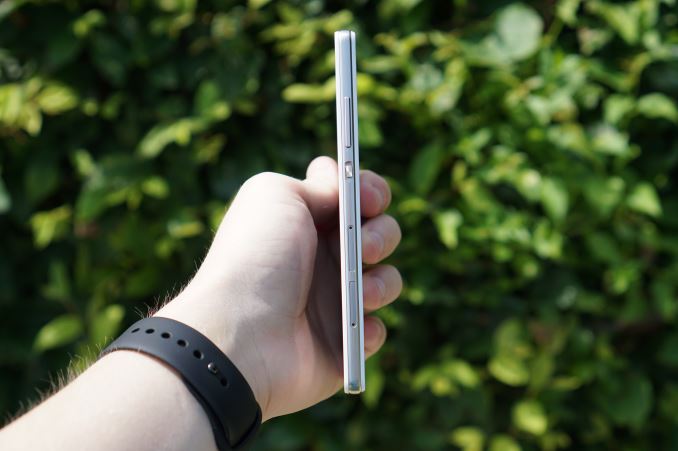The Huawei P8 Lite Review
by Brandon Chester on July 27, 2015 8:00 AM EST- Posted in
- Smartphones
- Huawei
- Mobile

Although many consumers are not familiar with Huawei, they are a company that has been selling smartphones for quite some time now. In the earliest days of the smaller Canadian carriers Huawei was one of the few companies that had smartphones available on their networks due to their use of the AWS band for HSPA which was uncommon in other devices here at the time. While Huawei has always had one or two flagship devices and makes some phablets, to me their core market was always mid range devices. Often these mid range devices are a downsized version of their flagship devices, and the smartphone being reviewed today is no exception. It's the Huawei P8 Lite, and it's the little brother of the Huawei P8.
The P8 Lite is Huawei's device to compete in the mid $200 market. At $249, it's more expensive than a device like the Zenfone 2, but not as expensive as something like the OnePlus One. There are actually two versions of the P8 Lite depending on your market. The first uses HiSilicon's Kirin 620 SoC which has eight Cortex A53 cores at 1.2GHz, while the second uses Qualcomm's Snapdragon 615 SoC. The version being examined during this review is the Qualcomm edition, and you can check out the rest of its specifications in the chart below.
| Huawei P8 Lite | ||||||
| SoC | Qualcomm Snapdragon 615 4x ARM Cortex A53 at 1.5 GHz 4x ARM Cortex A53 at 1.11 GHz Adreno 405 at 550 MHz |
|||||
| Memory and Storage | 2GB LPDDR3 RAM, 16GB NAND + MicroSDXC | |||||
| Display | 5.0" 1280x720 IPS LCD | |||||
| Cellular Connectivity | 2G / 3G / 4G LTE (Qualcomm MDM9x25 IP UE Category 4 LTE) | |||||
| Dimensions | 143 x 70.6 x 7.7 mm, 131g | |||||
| Cameras | 13MP Rear Facing w/ 1.12 µm pixels, 1/3.06" CMOS size, F/2.0, 28mm (35mm effective) 5MP Front Facing, F/2.4, 22mm (35mm effective) |
|||||
| Battery | 2200 mAh (8.36Wh) | |||||
| Other Connectivity | 802.11b/g/n + BT 4.0, GNSS, microUSB 2.0 | |||||
| Operating System | Android 4.4 KitKat With Emotion UI 3.0 | |||||
| SIM | MicroSIM | |||||
| Price | $249 | |||||
On paper, the P8 Lite sits right in the mid range segment of the market. Inside it has Qualcomm's Snapdragon 615 SoC, with two clusters of four Cortex A53 cores and their Adreno 405 GPU. Other internal specs include 2GB of RAM, 16GB of internal storage, an 8.36Wh battery, and 802.11n WiFi. On the outside is the 5" 1280x720 IPS display, and a pair of rear and front cameras with 13MP and 5MP resolutions respectively.
On the software side we see that the P8 Lite is only shipping with Android KitKat skinned with Huawei's Emotion UI. Andrei has already taken a look at the iterations of this interface on a number of occasions, and there's not much I can add to his evaluation of Emotion UI 3.0 from his review of the Ascend Mate 7 so I'll simply link that here for interested readers. The underlying version of Android being KitKat is definitely disappointing when the P8 Lite is being sold in July of 2015 with Android M on the horizon, and it means that the Snapdragon 615 SoC has to run in AArch32 mode. The P8 Lite and all its hardware and software comes together in a 7.7mm thick package that costs $249.
The design of the P8 Lite definitely takes some cues from the larger high end Huawei P8. The front of the phone is remarkably similar, with the same outer white bezel surrounding a black bezel around the display. On the top bezel we have the earpiece, front-facing camera, and the proximity sensor. On the bottom is nothing but Huawei's name, as the P8 Lite uses onscreen navigation buttons. As far as differences from the P8 go, the black bezel around the display is thicker on the left and right sides, and the camera and earpiece have more spacing between them and the earpiece.
While the Huawei P8 has an aluminum chassis, the P8 Lite is very clearly made of plastic. The sides and rear of the phone are significantly different from the P8. To add a bit of flare to the plastic chassis Huawei has added a plastic band that attempts to mimic the appearance of metal. From the side it kind of reminds me of an ice cream sandwich due to the two outer layers of the same color and a different inner layer. Huawei has also put their power button, SIM slot, and microSD slots on the right side in the same fashion as the P8. While some people might like the metal appearance of the outer band, I'm not really a big fan. When making a plastic device you either need to own it and use it to your advantage like Nokia/Microsoft does with their Lumia devices, or you need to make it look very convincing like the back cover of the Zenfone 2. In the P8 Lite's case it still looks very much like plastic, and reminds me of the fake chrome on the bezel of my Galaxy S i9000.
The back of the P8 Lite has two segments. At the top is a glossy thin strip which holds the rear-facing camera and LED flash on the left side. Everything below is a more textured plastic, with horizontal lines running across it. As far as construction goes, there's not really any flex or give to the back cover, and the texture created by the lines makes it feel different in the hand than a device like the Moto E or Moto G.
My opinion of the P8 Lite's design and build quality is somewhat divided. It has a good feel in your hand, and there's no flex or anything that would suggest weakness. On the other hand, I really don't like the faux-metal band around the edge of the phone. Trying to mimic brushed aluminum with plastic is always going to backfire, and I think Huawei would have been better off just making the sides white like the rest of the chassis.












45 Comments
View All Comments
joeroyhud - Monday, July 27, 2015 - link
The P8 Lite supports LTE band 12, which makes it attractive if you're a T-Mobile customer like I am. I got the phone on sale a couple months ago for $200. I like the size and the performance and the battery life, but it's overpriced at $250.Glock24 - Monday, July 27, 2015 - link
This phone seems like a bad choice. Glad I got a ZenFone 2, but sure since I got the 4GB RAM/64GB flash version it cost me $300. Battery life on ZF2 is not great, but has improved a bit with system updates. I guess if the P8 Lite had Android 5.0 it would have even worse battery life.austinsguitar - Monday, July 27, 2015 - link
g4 pleaseedwd2 - Monday, July 27, 2015 - link
SD615 is a plain no for me. It's arguably worse than the SD600 and the MT6752 smokes it in every aspect at a lower price point.Speedfriend - Tuesday, July 28, 2015 - link
"As for performance, Snapdragon 615 is really the best you're going to get at this price point unless you go with the Zenfone 2 which is something of an anomaly in many ways. "Which begs the question why more manufacturers aren't using Intel chips which clearly smash the performance of any other mid range priced offerings?
Stick an Intel chip in a Moto G and I'll buy that!
LiverpoolFC5903 - Tuesday, July 28, 2015 - link
Agree, I dont understand why more manufacturers do not use the newer Silvermont based Intel chips, considering the performance levels and the low price. Much better than using mediocre socs like Snapdragon 410/615 at similar price points. Having used the ZF2, I can personally attest to its performance in handling anything Android has to offer.Buk Lau - Wednesday, July 29, 2015 - link
The answer is simple, Intel chips don't come with integrated modems. just look at zenfone 2, that thing comes with XMM 7262 with CAT 6 LTE disabled, and if this doesn't show you the problem already, Qualcomm's Gobi modem even comes with integrated GPS solution whereas Asus has to include a Broadcom solution. so just by using these atoms you already have to include 2 other chips whereas Qualcomm just gives you an all-in-one solution. then the choice is obvious, unless intel is literally paying money to you, which they did, what incentive is there for you to use their more complicated solution instead of qualcomm's? and this is how qualcomm got to become what it is today. back in the old days qualcomm's SoCs suffered even worse overheating and performance and yet OEMs still persist to use their stuff, simply because they offered an integrated modem. in a sense, OEMs only have themselves to blame rather than qualcomm for having to release junk phones all over this year, if they didn't spoil qualcomm so much back then, there wouldn't be so little choices in the SoC marketBadelhas - Tuesday, July 28, 2015 - link
The European / Asian version has Lollipop UI Emotion 3.1 and the their own HiSilicon's Kirin 620 SoC. Is it possible to review that one? Seems much better than the American version...A friend of mine bought one and it´s pretty slick, even if I continue to prefer the Moto E, considering the price.
PrinceGaz - Tuesday, July 28, 2015 - link
eww, you've got really hairy arms! (just joking, there were complaints in the comments about the iWatch that the guy wearing it had hairless arms :)So why would I want a phone with eight A53 CPUs? In my experience with a quad-core tablet, it rarely uses more than two of them fully when it is running at full speed, with the third and fourth cores doing a bit of work but hardly ever even approaching fully utilised (probably just running the tasks that need to be run anyway, so their main purpose is taking a tiny bit of work off the other cores).
Given that a 64-bit CPU is a bit unnecessary when phones have yet to reach 4GB RAM, and probably counter-productive power-wise as a result (just look at A15/A7 vs A57/A53), whilst benchmarks may run faster on a quad-core 1.5GHz A53, I suspect I'm better off with my old dual-core 1.7GHz Krait for most daily usage. It lasts me all day and never feels slow, and most of the time (according to a CPU usage monitor) one of the cores isn't being used much. I don't play 3D games much on my phone; so I never tax the GPU, therefore the Adreno 305 is perfectly fine for me,
What workload other than benchmarks requires more than two CPU cores? The main one that occurs to me is a browser, in which case you would be much better off culling battery draining processes rather than running them.
Ethos Evoss - Saturday, August 1, 2015 - link
pls honor 7 reviewthnx